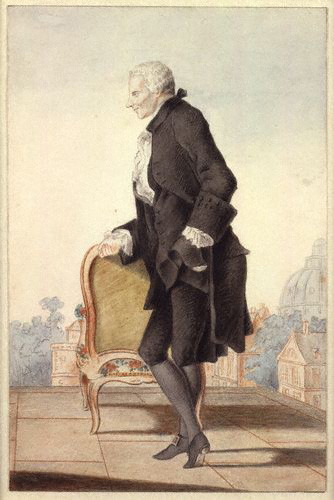.
Polar Bear (Ursus maritimus), Arctic National Wildlife Refuge, Alaska: photo by Alan D. Wilson, 2007
My father took a single turn across the room, then sat down and finished the chapter.
The verbs auxiliary we are concerned in here, continued my father, are, am; was; have; had; do; did; make; made; suffer; shall; should; will; would; can; could; owe; ought; used; or is wont.---And these varied with tenses, present, past, future, and conjugated with the verb see,--- or with these questions added to them;---Is it? Was it? Will it be? Would it be? May it be? And these again put negatively, Is it not? Was it not? Ought it not?---Or affirmatively,---It is; It was; It ought to be. Or chronologically, Has it been always? Lately? How long ago? Or hypothetically,---If it was? If it was not? What would follow?---If the French should beat the English? If the Sun go out of the Zodiac?
Now, by the right use and application of these, continued my father, in which a child's memory should be exercised, there is no one idea can enter his brain how barren soever but a magazine of conceptions and conclusions may be drawn forth from it.----Didst thou ever see a white bear? cried my father, turning his head round to Trim, who stood at the back of his chair:---No, an'please your honour, replied the corporal.-----But thou could'st discourse about one, Trim, said my father, in case of need?----How is it possible, brother, quoth my uncle Toby, if the corporal never saw one?-----'Tis the fact I want; replied my father,---and the possibility of it, is as follows:
A WHITE BEAR! Very well. Have I ever seen one? Might I ever have seen one? Am I ever to see one?
Ought I ever to see one? Or can I ever see one?
Would I had seen a white bear! (for how can I imagine it?)
If I should see a white bear, what should I say? If I should never see a white bear, what then?
If I never have, can, must or shall see a white bear alive; have I ever seen the skin of one? Did I ever seen one painted?---described? Have I ever dreamed of one?
Did my father, mother, brothers or sisters, ever see a white bear? What would they give? How would they behave? How would the white bear have behaved? Is he wild? Tame? Terrible? Rough? Smooth?
---Is the white bear worth seeing?---
---Is there no sin in it?---
---Is it better than a BLACK ONE?
Laurence Sterne: from The Life & Opinions of Tristram Shandy, Gentleman, Volume V, 1762 (Chapter XLIII)
The Importance of Knowing Perspective (Absurdities of False Perspective): William Hogarth, 1754
Digressions, incontestably, are the sunshine;---they are the life, the soul of reading!---take them out of this book, for instance,---you might as well take the book along with them;---one cold eternal winter would reign in every page of it; restore them to the writer;---he steps forth like a bridegroom,---bids All-hail; brings in variety, and forbids the appetite to fail.
Laurence Sterne: from The Life & Opinions of Tristram Shandy, Gentleman, Volume I, 1760 (Chapter XXII)
Laurence Sterne: Louis Carrogis Carmontelle, c. 1762 (National Portrait Gallery, London)
Sterne was a radical revolutionary as far as form is concerned. It was typical of him to lay bare the device. The aesthetic form is presented without any motivation whatsoever, simply as is. The difference between the conventional novel and that of Sterne is analogous to the difference between a conventional poem with sonorous instrumentation and a Futurist poem composed in transrational language...
Upon first picking up Sterne’s Tristam Shandy, we are overwhelmed by a sense of chaos.
The action constantly breaks off, the author constantly returns to the beginning or leaps forward. The main plot, not immediately accessible, is constantly interrupted by dozens of pages filled with whimsical deliberations on the influence of a person’s nose or name on his character or else with discussions of fortifications.
The book opens, as it were, in the spirit of autobiography, but soon it is deflected from its course by a description of the hero’s birth. Nevertheless, our hero, pushed aside by material interpolated into the novel, cannot, it appears, get born.
Tristram Shandy turns into a description of one day. Let me quote Sterne himself:
I will not finish that sentence till I have made an observation upon the strange state of affairs between the reader and myself, just as things stand at present—an observation never applicable before to any one biographical writer since the creation of the world; but to myself—and I believe will never hold good to any other, until its final destruction—and therefore, for the very novelty of it alone, it must be worth your worships attending to.
I am this month one whole year older than I was this time twelve-month; and having got, as you perceive, almost into the middle of my fourth volume—and no farther than to my first day’s life—’tis demonstrative that I have three hundred and sixty-four days more life to write just now, than when I first set out; so that instead of advancing, as a common writer, in my work with what I have been doing at it—on the contrary, I am just thrown so many volumes back—
But when you examine the structure of the book more closely, you perceive first of all that this disorder is intentional. There is method to Sterne’s madness. It is as regular as a painting by Picasso.
Everything in the novel has been displaced and rearranged...
It is common practice to assert that Tristram Shandy is not a novel. Those who speak in this way regard opera alone as true music, while a symphony for them is mere chaos.
Tristram Shandy is the most typical novel in world literature.
Viktor Shklovsky: from Laurence Sterne: The Novel as Parody, 1925

The Staymaker: William Hogarth, c. 1745 (Tate Collection)


